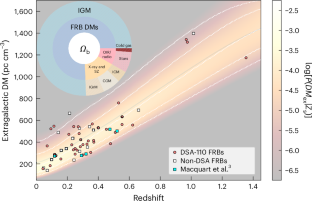2025-06-16 カリフォルニア工科大学 (Caltech)
<関連情報>
- https://www.caltech.edu/about/news/missing-matter-in-universe-found
- https://www.nature.com/articles/s41550-025-02566-y
失われた重粒子の分割によって明らかになったガスに富む宇宙網 A gas-rich cosmic web revealed by the partitioning of the missing baryons
Liam Connor,Vikram Ravi,Kritti Sharma,Stella Koch Ocker,Jakob Faber,Gregg Hallinan,Charlie Harnach,Greg Hellbourg,Rick Hobbs,David Hodge,Mark Hodges,Nikita Kosogorov,James Lamb,Casey Law,Paul Rasmussen,Myles Sherman,Jean Somalwar,Sander Weinreb,David Woody & Ralf M. Konietzka
Nature Astronomy Published:16 June 2025
DOI:https://doi.org/10.1038/s41550-025-02566-y

Abstract
Approximately half of the Universe’s dark matter resides in collapsed halos; significantly less than half of the baryonic matter (protons and neutrons) remains confined to halos. A small fraction of baryons are in stars and the interstellar medium within galaxies. The majority are diffuse (<10−3 cm−3) and ionized (neutral fraction <10−4), located in the intergalactic medium (IGM) and in the halos of galaxy clusters, groups and galaxies. This diffuse ionized gas is notoriously difficult to measure, but has wide implications for galaxy formation, astrophysical feedback and precision cosmology. Recently, the dispersion of extragalactic fast radio bursts (FRBs) has been used to measure the total content of cosmic baryons. Here we present a large cosmological sample of FRB sources localized to their host galaxies. We have robustly partitioned the missing baryons into the IGM, galaxy clusters and galaxies, providing a late-Universe measurement of the cosmic baryon abundance, Ωbh70=0.051+0.006−0.006, where Ωb is the baryon density parameter and h70 is the scaled Hubble constant. Our results indicate efficient feedback processes that can deplete galaxy halos and enrich the IGM (total baryon fraction in the IGM is fIGM=0.76+0.10−0.11), agreeing with the baryon-rich cosmic web scenario seen in cosmological simulations. Our results may reduce the ‘S8 tension’ in cosmology, as strong feedback leads to suppression of the matter power spectrum.



